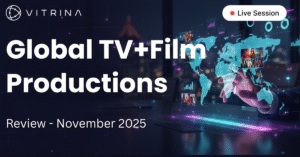Introduction
For any major film or television project, selecting a visual effects partner is one of the most critical decisions you will make.
The right VFX company acts as a true creative collaborator, while the wrong choice introduces significant risk to your budget, timeline, and the final quality of your production. In my analysis of the M&E supply chain, the primary challenge executives face is navigating a global market of vendors with inconsistent and often unverified data.
This guide provides a data-driven framework for evaluating and selecting a world-class top 10 VFX companies.
The insights are powered by Vitrina’s global intelligence platform, which tracks the projects, capabilities, and key executives at thousands of vendors. By the end, you will have a clear methodology for transforming this high-stakes decision into a strategic, data-backed discipline.
Table of content
- Methodology: How This List of Top VFX Companies Was Chosen
- The Definitive List of Top 10 VFX Companies for 2025
- Beyond the Top 10: How to Discover and Vet Emerging VFX Talent
- Conclusion: Making Data-Driven Decisions in a Creative Industry
- Frequently Asked Questions
- Beyond the Top 10: How to Discover and Vet Emerging VFX Talent
- Conclusion: Making Data-Driven Decisions in a Creative Industry
- Frequently Asked Questions
Key Takeaways
| Topic | Executive Summary |
|---|---|
| The Core Challenge | Selecting a VFX partner is a high-stakes business decision fraught with risk due to fragmented data and a lack of transparency in vendor capabilities. |
| The Strategic Solution | A data-driven vetting process is required, focusing on a vendor’s verified track record, technological innovation, global scale, and specialization alignment with project needs. |
| The Role of Vitrina | Vitrina’s intelligence platform addresses this by providing deep, verified profiles on over 15,000 global vendors, enabling executives to discover and vet partners systematically. |
| Market Reality | The top-tier VFX houses represent the gold standard, but a robust strategy requires visibility into the entire global market to find the right partner for every type of project. |
Methodology: How This List of Top VFX Companies Was Chosen
This is not merely a list of the biggest names. As a strategist, my criteria for inclusion are rooted in a multi-faceted analysis of a company’s standing and influence within the global M&E supply chain. The firms detailed below have been selected based on a rigorous evaluation of four key pillars, ensuring this guide is a trustworthy resource for executive decision-making.
- Major Awards & Industry Recognition: Consistent wins and nominations at the highest levels, including the Academy Awards, BAFTAs, and the Visual Effects Society (VES) Awards. This serves as third-party validation of their quality and creative excellence.
- Contribution to Landmark Projects: A proven track record of working on critically and commercially significant projects. This demonstrates their ability to perform under pressure and collaborate effectively with top-tier directors and studios.
- Technological Innovation and Leadership: Actively pioneering new technologies and workflows, such as virtual production, real-time rendering, or AI-driven character animation. This signals a forward-thinking partner capable of handling the demands of modern production.
- Global Scale and Infrastructure: A significant global footprint with studios in key production hubs. This indicates financial stability, a deep talent pool, and the capacity to manage large-scale, complex projects across multiple territories.
Instantly View Portfolio Samples of Local Studios

The Definitive List of Top 10 VFX Companies for 2025
The following companies represent the pinnacle of the visual effects industry. They are the partners the world’s largest studios and streamers trust with their most valuable IP. Understanding their unique strengths is the first step in aligning your project with the right creative and technical powerhouse.
1. Industrial Light & Magic (ILM)
Strategic Overview: Founded by George Lucas, ILM is not just a company; it is an institution that invented much of the modern VFX vernacular. From pioneering computer-generated imagery to leading the current revolution in virtual production with its StageCraft LED volumes, ILM remains the industry’s North Star. Their deep integration with Lucasfilm and Disney provides them with an unparalleled R&D feedback loop.
Core Specializations: Virtual Production (StageCraft), Photorealistic Creature & Character Animation, Complex FX Simulations, Digital Environments.
Recent Landmark Projects: The Mandalorian, The Batman, Avatar: The Way of Water, The Creator.
Why They Matter for Executives: Engaging ILM is the ultimate de-risking strategy for a tentpole project. They represent the gold standard for innovation, reliability, and seamless pipeline integration at the highest possible scale. Their mastery of virtual production is a critical factor for any executive looking to optimize production efficiency and creative control.
2. DNEG
Strategic Overview: DNEG has become a dominant force in the industry, building a reputation on breathtaking photorealism and a staggering run of Academy Award wins for Best Visual Effects. Their strength lies in grounding fantastical concepts in tangible reality, making them a preferred partner for visionary directors like Christopher Nolan and Denis Villeneuve.
Core Specializations: Photorealistic Integrated VFX, Complex Environmental Simulations (water, sand, fire), On-Set Supervision, Animation.
Recent Landmark Projects: Dune: Part Two, Oppenheimer, Tenet, Stranger Things, The Last of Us.
Why They Matter for Executives: DNEG is the partner you turn to when “good enough” is not an option. Their proven ability to deliver award-winning work on complex, story-driven films makes them a trusted choice for projects where the visual effects are integral to the narrative’s success. Their global footprint also offers significant capacity and flexibility for large-scale productions.
3. Framestore
Strategic Overview: With a unique dual heritage in both blockbuster films and high-end advertising, Framestore brings an exceptional level of creative polish and design sensibility to its work. They are world-renowned for their character and creature animation, consistently delivering performances that are both technically flawless and emotionally resonant.
Core Specializations: Creature & Character Animation, Ride Films & Immersive Experiences, Design & Pre-production, Color Grading.
Recent Landmark Projects: Guardians of the Galaxy Vol. 3, The Little Mermaid, His Dark Materials, Barbie.
Why They Matter for Executives: When the success of your project hinges on the audience falling in love with a digital character, Framestore is on the shortlist. Their deep expertise in creating believable, beloved creatures is a key differentiator. Furthermore, their leadership in immersive entertainment makes them a strategic partner for expanding IP into theme parks and other location-based experiences.
4. MPC (Moving Picture Company)
Strategic Overview: As part of the Technicolor Creative Studios family, MPC is a global giant with a robust, scalable pipeline capable of handling multiple blockbuster projects simultaneously. They are known for their exceptional creature work and large-scale environmental builds, demonstrated in their groundbreaking work on Disney’s photorealistic remakes.
Core Specializations: Photorealistic Creature Animation, Full CG Environments, Crowd Simulation, Pre-production.
Recent Landmark Projects: The Lion King (2019), 1917, Godzilla vs. Kong, Prehistoric Planet.
Why They Matter for Executives: MPC’s sheer scale and global network of talent make them a highly reliable partner for executing massive VFX workloads. For productions requiring the creation of entire digital worlds or complex, photorealistic animals, MPC’s proven pipeline and deep bench of artists offer a dependable path to success.
5. Digital Domain
Strategic Overview: For over three decades, Digital Domain has been a leader in technological innovation. They are undisputed pioneers in the creation of believable “digital humans,” consistently pushing the boundaries of what is possible in digital performance and facial animation. Their work on characters like Thanos has set a new industry benchmark.
Core Specializations: Digital Humans & “Synthespians,” Advanced Facial Animation, High-Fidelity FX Simulations, Virtual Reality.
Recent Landmark Projects: Avengers: Endgame, Ready Player One, Spider-Man: No Way Home.
Why They Matter for Executives: When a script calls for a photorealistic digital human or the de-aging of a principal actor, Digital Domain is one of the few specialists in the world with a proven track record of success. Their continuous R&D in AI and machine learning makes them a forward-thinking partner for the most technically demanding projects.
6. Pixomondo
Strategic Overview: Best known for its Emmy-winning work on the dragons in Game of Thrones, Pixomondo has strategically evolved into a leader in virtual production. With an international network of studios and integrated LED stages, they have become a key technology and service partner for high-end episodic content, particularly for major streamers.
Core Specializations: Virtual Production, TV Episodic VFX, Creature Animation, Pre-visualization.
Recent Landmark Projects: House of the Dragon, The Mandalorian, Star Trek: Discovery, Halo.
Why They Matter for Executives: Pixomondo offers a powerful solution for television productions seeking the efficiency and creative benefits of virtual production. Their expertise in managing complex episodic workflows, combined with their state-of-the-art technology, makes them a vital partner for showrunners and producers in the prestige TV space.
7. The Mill
Strategic Overview: The Mill is a world-renowned creative studio that has dominated the high-end advertising space for decades, bringing that same level of visual artistry and innovation to film, television, and experiential projects. Their work is defined by a polished, design-led aesthetic and technical excellence, particularly in color grading and finishing.
Core Specializations: High-End Commercials, Experiential (AR/VR), Design & Animation, Color Grading & Finishing.
Recent Landmark Projects: Countless award-winning campaigns for global brands like Apple and Nike; VFX for series like Doctor Who and Severance.
Why They Matter for Executives: For entertainment projects that require a strong design sensibility or for brands creating tentpole advertising, The Mill is unparalleled. Their deep expertise in short-form storytelling and audience engagement provides unique value. They are also a key partner for navigating the convergence of entertainment and advertising.
8. Crafty Apes
Strategic Overview: Crafty Apes represents a new breed of VFX powerhouse. They have experienced meteoric growth by building a talent-centric, distributed model that allows them to service a massive volume of high-profile film and television projects. They are known for their collaborative spirit and ability to deliver consistently high-quality compositing and on-set work.
Core Specializations: High-Volume 2D Compositing, On-Set Supervision, Episodic VFX Pipelines.
Recent Landmark Projects: Stranger Things, Spider-Man: No Way Home, Loki, Doctor Strange in the Multiverse of Madness.
Why They Matter for Executives: Crafty Apes is a go-to partner for major studios and streamers that need a reliable, high-capacity vendor for large slates of content. Their ability to seamlessly integrate with production and handle quick turnarounds on complex episodic shows makes them an invaluable part of the modern M&E supply chain.
9. Weta FX
Strategic Overview: The New Zealand-based studio, co-founded by Peter Jackson, is legendary for its revolutionary work on The Lord of the Rings trilogy. Weta FX continues to be the undisputed world leader in performance capture technology and the creation of deeply compelling, emotionally complex digital characters. Their ability to build entire, believable worlds from scratch is unmatched.
Core Specializations: Performance Capture, Digital Characters & Creatures, Large-Scale World-Building, Advanced Water & FX Simulations.
Recent Landmark Projects: Avatar: The Way of Water, Kingdom of the Planet of the Apes, Godzilla x Kong: The New Empire.
Why They Matter for Executives: For any project whose success depends on groundbreaking performance capture or the creation of iconic digital characters, Weta FX is in a category of its own. Their name is synonymous with epic, world-building cinema, making them a cornerstone partner for franchise-level IP.
10. Rodeo FX
Strategic Overview: Based in Montreal, a key global VFX hub, Rodeo FX has carved out a reputation as a master of “invisible effects.” They specialize in creating stunningly realistic environments and seamless enhancements that serve the story without drawing attention to themselves. This has made them an indispensable partner for many of the most acclaimed drama and sci-fi series in prestige television.
Core Specializations: Invisible VFX, Digital Matte Painting & Environments, TV Episodic Workflows.
Recent Landmark Projects: Stranger Things, Foundation, The Witcher, John Wick: Chapter 4.
Why They Matter for Executives: Rodeo FX is the partner you choose when you need to build immersive worlds that feel utterly real. Their expertise is critical for grounded dramas, historical epics, and science fiction series where the believability of the environment is paramount to audience immersion. They are a proven provider of consistent, high-quality work for the demanding pace of episodic television.
Access Verified VFX Professionals by Region

Beyond the Top 10: How to Discover and Vet Emerging VFX Talent
The ten companies listed above represent the industry’s elite, but they are often booked years in advance on the world’s biggest projects. What about your other films? Your new series? How do you discover the next Weta FX or DNEG before they become household names? This is a critical strategic challenge for any growing studio or production company.
The traditional methods of relying on film market meetings or word-of-mouth are inefficient and leave you with a narrow view of the global talent pool. To build a truly resilient and competitive production pipeline, you need a systematic way to survey the entire market, including specialized boutiques and rising stars in emerging hubs across Asia, Latin America, and Europe. This is where a dedicated intelligence platform becomes indispensable.
Vitrina is engineered to solve this exact problem. It provides the tools to move beyond the usual suspects and build a dynamic, global network of trusted creative partners.
- Discover Specialized Partners Globally: Instead of relying on anecdotal evidence, you can use Vitrina’s platform to search and filter over 15,000 post and service vendors worldwide. You can find partners based on specific capabilities, such as “VFX studios in Eastern Europe that have worked with US networks”, ensuring you find the right fit for every project’s unique needs.
- Vet Company Track Records with Verified Data: Move beyond a glossy marketing deck. Vitrina provides deep company profiles that include verified client histories, key executive contacts, and detailed service descriptions. This allows you to qualify potential partners based on their actual track record, not just their sales pitch.
- Connect Directly with Decision-Makers: Time is your most valuable asset. Vitrina helps you bypass gatekeepers by providing access to a database of over 3 million verified executive profiles. Connect directly with the producers, department heads, and financiers who can make strategic decisions.
- Maintain a Competitive Edge: Use the Vitrina Project Tracker to monitor which vendors your competitors are hiring for their upcoming slates. This provides real-time market intelligence, revealing which smaller studios are being trusted with significant work and signaling them as potential partners for you.
Don’t limit your creative partnerships to a static top-10 list. The best partner for your next project might be a specialized studio you’ve never heard of. Schedule a demo of Vitrina to see how you can map the entire global VFX landscape and find the perfect vendor for any project, at any scale.
Conclusion: Making Data-Driven Decisions in a Creative Industry
In today’s global M&E landscape, choosing a VFX company is a critical strategic decision, not just a line item in a budget. The firms listed in this guide represent the pinnacle of artistic and technical achievement, but they are just the top of a very large and talented pyramid. The “old way” of sourcing partners through personal networks is no longer sufficient to compete on a global scale.
A systematic, data-driven approach to discovering, vetting, and managing creative vendors is the new professional standard. It mitigates risk, uncovers hidden opportunities, and frees up your creative and business development teams to focus on what they do best: building relationships and producing great content. This disciplined approach is what separates market leaders from the rest of the pack.
By using an intelligence platform like Vitrina, you equip your organization with the ability to see the entire field. You can build a diverse, resilient, and global pipeline of trusted partners, ensuring that every project—from independent features to tentpole franchises—has the best possible creative and technical support. Ultimately, this is how you build sustainable success and keep your content slate competitive for years to come.
Frequently Asked Questions
The choice depends on three factors: specialization, scale, and budget. First, match the studio’s core specialty (e.g., character animation, invisible effects, virtual production) to your project’s primary creative need. Second, ensure the studio has the scale and pipeline to handle the volume of work required in your timeline. Finally, engage with potential partners whose budget level aligns with your resources.
Large houses like ILM or DNEG offer immense scale, deep talent pools, and robust, secure pipelines capable of handling massive blockbuster projects. Boutique studios often provide highly specialized services, more direct access to senior creative talent, and potentially more agility. The right choice depends entirely on the specific needs of your project.
Yes—if they show proven track record, verified infrastructure, and executive accessibility.
Several regions are major hubs, often driven by government tax incentives. Key locations include London (UK), Vancouver and Montreal (Canada), and Los Angeles (USA). However, there are world-class studios and emerging hubs across the globe, including in Australia, New Zealand, Germany, and India. A global discovery tool is essential to gain visibility into all of these talent pools.




























